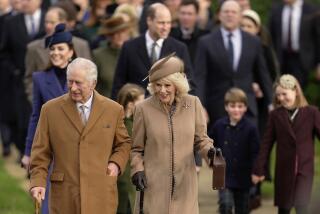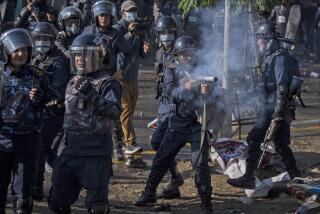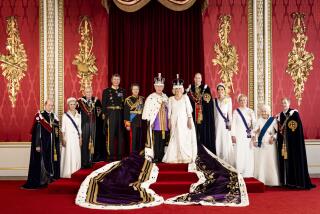Nepalis Calling for End to Monarchy
- Share via
KATMANDU, Nepal — He ascended to the throne after the bloody palace massacre of eight of his royal relatives. Now the deaths of at least a dozen of his subjects, at the hands of security forces acting in his name, could bring down King Gyanendra -- and sweep away Nepal’s centuries-old monarchy altogether.
For two weeks, this land of Mt. Everest and free-flowing spirituality has been awash with protests demanding an end to the king’s autocratic rule. Gyanendra ordered parliament dissolved four years ago and dismissed the government last year in an effort to crush a rebellion.
On Saturday, thousands of demonstrators defied a daytime curfew and took to the streets again, clashing with authorities who drove them back with batons, rubber bullets and tear gas. Dozens were reported injured.
A couple of weeks ago, many Nepalis still saw a role for Gyanendra as their constitutional monarch here in the world’s only Hindu kingdom. But after security forces with shoot-on-sight orders killed at least 12 protesters, public opinion has hardened, and those once willing to accommodate the king now insist on nothing short of a republic.
It would be a tectonic shift in a nation where the monarchy has long been seen like the surrounding Himalaya mountains -- immovable, revered and as old as time. It would plunge Nepal into deep uncertainty as a seven-party alliance held together only by opposition to the king scrambled to fill the power vacuum.
But on streets where the king is burned in effigy and protesters howl for his hanging, Nepalis appear ready to accept the risk of instability. They scoff at the olive branch Gyanendra extended Friday, an offer to let the opposition name a prime minister, as too little, too late.
“If he had come out with this solution [earlier], people would have accepted it,” said engineer Om Shrestha, 46, military helicopters flying overhead as a crowd of young men chanted, burned tires and whistled. “But these last three to four days, things have changed, and the people have gone a step ahead.”
The alliance issued a formal statement Saturday rejecting Gyanendra’s offer to let its members choose a prime minister and calling for popular unrest to continue. It also issued a 24-hour deadline for the king to meet its key demands: the restoration of parliament and the creation of a special assembly to revamp the constitution and determine whether to dump the monarchy.
But that question has already been answered in the minds of Nepalis such as Mukesh Sah, a 23-year-old medical student.
“He’s making a fool out of the people,” Sah said of the king. “We want a republic.”
The suddenness and ferocity of anti-royalist sentiment has taken many observers by surprise. Until recently, Nepalese kings were considered the incarnation of the Hindu god Vishnu. Their rule has been largely unquestioned, if not always enlightened, for more than 200 years. Gyanendra is the 12th ruler of the Shah dynasty.
“Three or four years ago, you would never hear anything against the king. It was the worst thing you could do,” said one longtime Western aid worker, who asked not to be identified for fear of jeopardizing her projects. “I can’t believe what I’m hearing in the streets.”
Throngs of people have openly called for the monarchy to be overthrown and the king to be lynched. Others throw out the epithet “brother-killer,” a reflection of a widespread belief that Gyanendra was somehow responsible for the deaths of his brother, King Birendra, the queen and several other members of the royal family who were gunned down in the palace in June 2001.
Gyanendra was declared king days later, and an investigation subsequently blamed the killings on the unhappy and volatile crown prince, Dipendra, who died of apparently self-inflicted wounds sustained during the massacre.
Popular support for the new king has always been tepid; many Nepalis view him as a spendthrift, possibly shady businessman rather than as monarch material. Disenchantment is especially rife among young people such as Sah, whose exposure to the Internet, global pop culture and other aspects of modern life has increased their skepticism of the monarchy. More than half of Nepal’s 28 million people are younger than 35.
Less than a year after acceding to the throne, Gyanendra ordered the suspension of parliament. Fourteen months ago, he sacked the government, contending that it was necessary in his battle against a Communist insurgency in the countryside that has claimed 13,000 lives.
In a major break heralding events to come, the Nepali Congress party, which for decades pledged to support a constitutional monarchy, decided last fall to drop that commitment.
Also, the seven-party opposition alliance joined in an uneasy accord with the Maoist rebels in November to try to force Gyanendra to give up absolute rule.
Still, the intensity of the pro-democracy protests of recent days and the sudden explosion of disgust with the king has caught even the alliance off guard. The republican rage on the streets made it difficult, if not impossible, for the coalition to accept Gyanendra’s offer Friday, said Yubaraj Ghimire, editor of the newsweekly Samay.
“The gap between the crowd, which is quite ferocious, and the political leaders is wide. They’re not quite comfortable facing the crowd and interacting with them,” Ghimire said.
The alliance is now squeezed between popular contempt for the king’s offer and heavy international pressure to accept it and name a prime minister. The United States, India and the United Nations have expressed some support for Gyanendra’s move, further inflaming tempers here.
“The Nepali people are not satisfied that the U.S. government is supporting this king,” said Shrestha, the engineer. He looks forward to a country without an unelected ruler.
Yet there is no clear sense here of what that would look like or how it would be achieved.
“They haven’t come up with a vision for what if the monarchy is abolished,” Ghimire, the editor, said of the opposition alliance. “To the extent of opposing the king, the seven parties are together. He is the cement that holds them together. I doubt whether if the king were not there, they would be unified.”
Worse yet, some analysts say, getting rid of the monarchy could allow the Maoists to declare victory, because overthrowing the king has long been their explicit aim.
As for what Gyanendra is planning, no one knows. With protesters dead, scores of activists imprisoned and the army out on the streets, few underestimate his determination to hold on to power. Rumors have swirled of further repressive measures by a king emboldened by what he sees as international backing.
Life has already gotten harder here, as a general strike and the curfews have shuttered shops and stopped goods from entering the capital. Residents have watched cupboards grow bare and prices rise.
Gyanendra remains holed up in his various palaces. .
In his nationally televised address Friday, in which he declared that “executive power ... shall, from this day, be returned to the people,” he appeared wooden and uncomfortable. He praised the army for its bravery and made no mention of the demonstrations or the deaths. Then, as quickly as he flickered onto TV screens, he flickered off, vanishing from sight as thousands of his subjects poured onto the streets like a flood.
More to Read
Sign up for Essential California
The most important California stories and recommendations in your inbox every morning.
You may occasionally receive promotional content from the Los Angeles Times.











